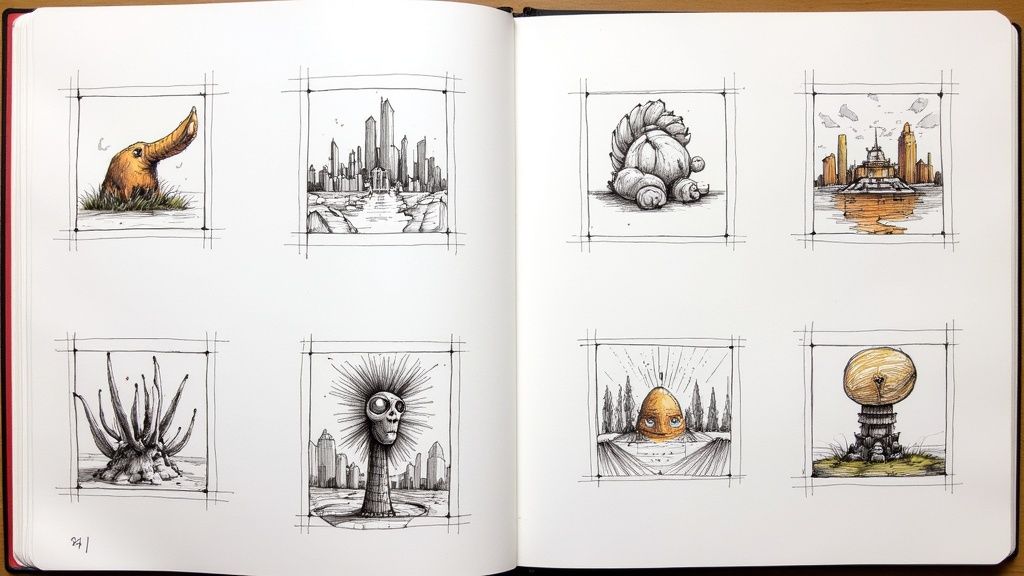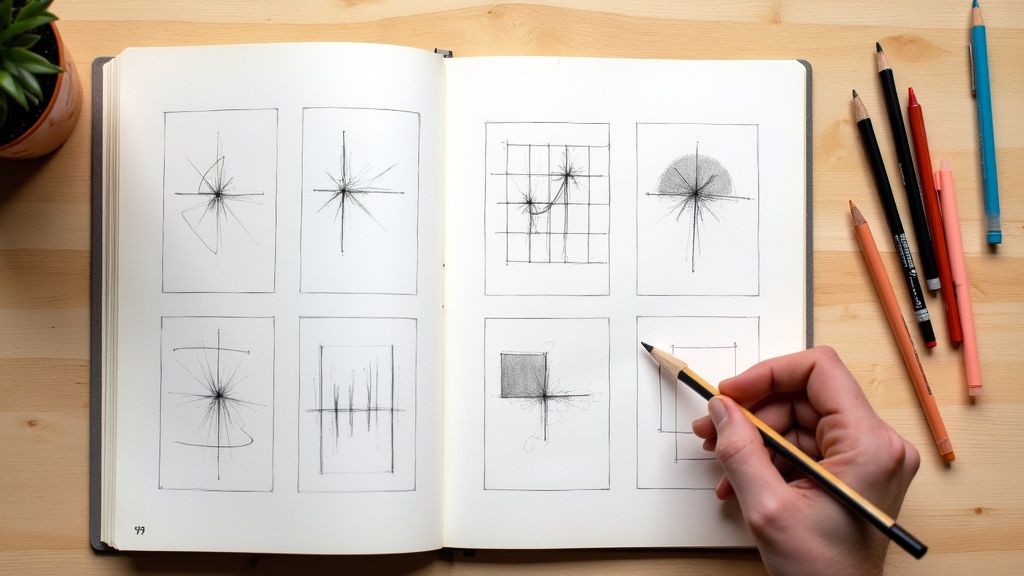Every artist, from seasoned illustrators to budding hobbyists, knows the challenge of a blank sketchbook page. The quest for compelling sketch drawing ideas can be as demanding as the drawing process itself. This guide moves beyond generic prompts, offering a curated collection of specific, actionable concepts designed to push your skills, spark your imagination, and fill your portfolio. We will explore a wide array of genres and subjects, from the foundational discipline of portraiture and still life to the dynamic worlds of character design and urban sketching.
Each idea is structured to provide not just a subject, but a framework for deliberate practice. This approach helps you focus on specific techniques like mastering perspective in architectural drawing, capturing motion in figure studies, or rendering texture in botanical illustration. By working through these targeted prompts, you will overcome creative blocks and build a versatile skill set.
This list provides a robust foundation for your artistic practice. You will discover unique angles for familiar subjects and find practical starting points for more complex projects. By the end, you'll have a rich library of inspiration, ensuring your sketchbook becomes a vibrant testament to your creative journey and technical growth.
1. Portrait Sketching
Portrait sketching is a timeless discipline focused on capturing the human face. It’s a foundational skill that challenges artists to translate likeness, emotion, and character onto a two-dimensional surface. This practice is more than just replicating features; it’s about understanding the underlying anatomy and conveying a subject's personality, making it a powerful and rewarding sketch drawing idea.
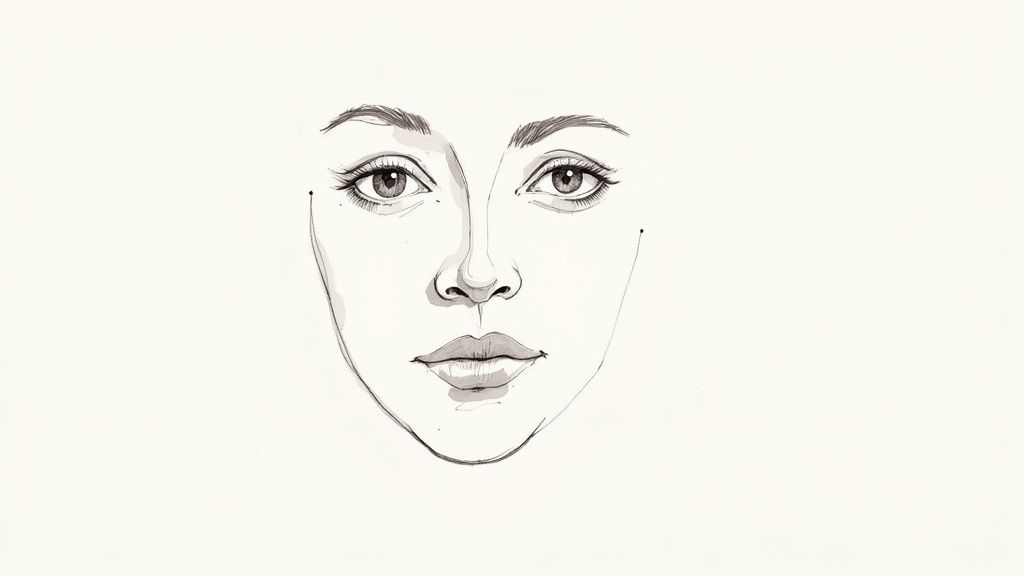
From Leonardo da Vinci’s anatomical studies to the expressive charcoal work of John Singer Sargent, portraiture has remained a cornerstone of artistic practice. The challenge lies in seeing beyond the surface to the geometric planes and structures that form the head.
How to Get Started
To begin, avoid getting lost in fine details like eyelashes or individual hairs. Instead, focus on the big picture to build a strong foundation for your drawing.
- Use Proportional Guidelines: Start with basic guides, like the Loomis method, to correctly place features. A common rule is that the eyes are located halfway down the head.
- Focus on Large Shapes First: Block in the general shape of the head, hair, and shadows. This helps establish the overall composition and lighting before committing to details.
- Draw from Life: While photos are convenient, drawing a live model teaches you to interpret three-dimensional form, light, and subtle expressions in a way a static image cannot.
- Start with Three-Quarter Views: This view reveals the most information about the face’s planes and dimensions, making it an excellent starting point before tackling more difficult front-on or profile views.
2. Nature and Landscape Sketching
Nature and landscape sketching involves capturing the essence of outdoor environments, from vast mountain ranges to the delicate details of a single leaf. This practice challenges artists to observe and interpret natural forms, light, and atmosphere. It's a wonderful sketch drawing idea for connecting with the world around you and honing your skills in composition, perspective, and creating a sense of depth.
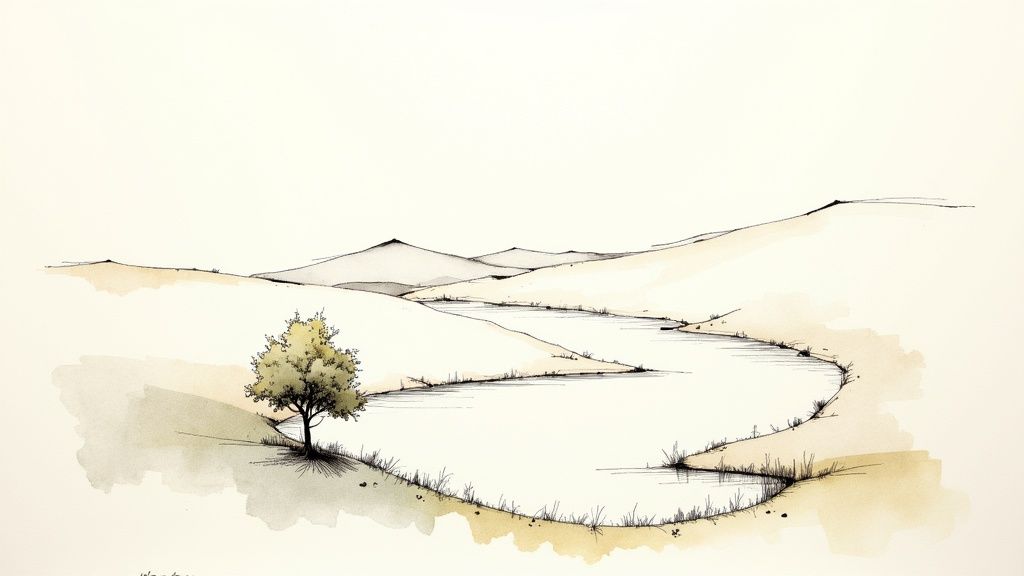
Artists like John Constable and Claude Lorrain pioneered landscape art, elevating it from a mere background element to the main subject. The practice, especially when done en plein air (outdoors), forces you to work quickly and decisively to capture fleeting moments of light and weather, developing a spontaneous and confident drawing style.
How to Get Started
To avoid feeling overwhelmed by the complexity of a natural scene, it's best to simplify your approach and focus on key elements that define the view.
- Use a Viewfinder: Create a simple cardboard viewfinder or use your hands to frame the scene. This helps you isolate compelling compositions and edit out distracting elements.
- Establish Big Shapes and Values First: Before drawing individual trees or rocks, block in the large shapes of the land, sky, and major shadows. This establishes a strong value structure and overall composition.
- Simplify Complex Textures: Suggest textures like foliage or rough bark rather than drawing every detail. Use varied marks, squiggles, and hatching to create the impression of texture.
- Study Atmospheric Perspective: Objects in the distance appear lighter, less detailed, and cooler in color. Use softer lines and lighter shading for faraway mountains or trees to create a realistic sense of depth.
3. Still Life Drawing
Still life drawing is a classical art exercise focused on sketching inanimate objects within a composed setting. It is an essential practice that allows artists to study fundamental principles like form, light, shadow, texture, and composition in a controlled environment. This discipline provides an excellent opportunity to explore how different elements interact, making it one of the most foundational and versatile sketch drawing ideas.
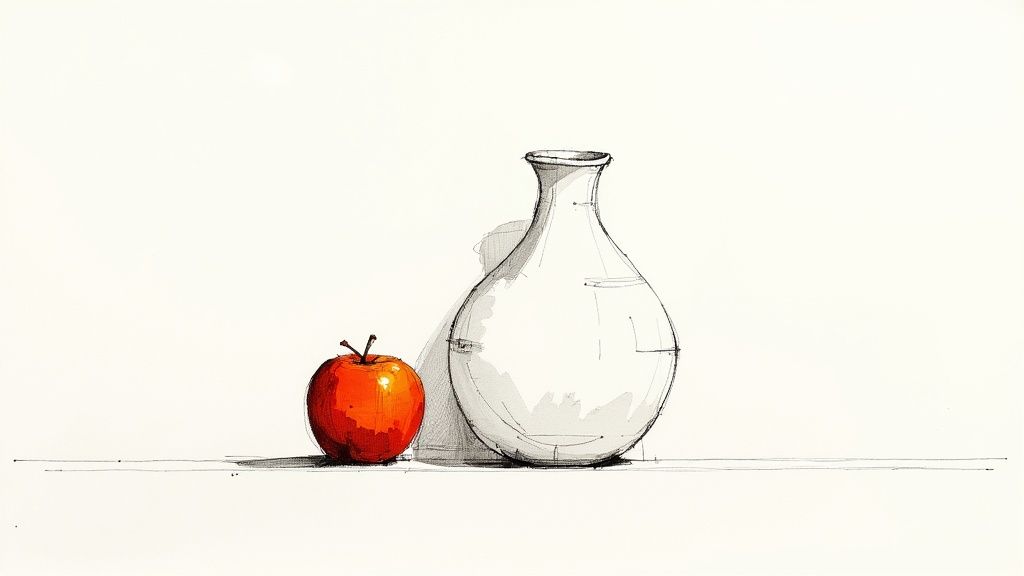
From the simple, meditative bottle arrangements of Giorgio Morandi to the lavish compositions of Jean-Baptiste-Siméon Chardin, still life offers infinite possibilities. The challenge lies in translating a three-dimensional arrangement into a compelling two-dimensional drawing that balances accuracy with artistic expression.
How to Get Started
The key to a successful still life sketch is a thoughtful setup and a structured approach. Focusing on the basics before adding detail will lead to a much stronger final piece.
- Arrange Objects with Overlapping Forms: Create visual interest and depth by placing objects so they overlap. Start with simple geometric items like boxes, spheres, and cylinders before moving to more complex forms.
- Use a Single, Strong Light Source: Position one distinct light source, like a lamp, to create clear, defined shadows. This makes it easier to understand how light falls across different surfaces and defines their forms.
- Study Material and Texture: Pay close attention to how different materials reflect or absorb light. A shiny metal cup will have sharp, bright highlights, while a piece of fruit will have softer, more diffused light.
- Practice Drawing Ellipses: Drawing circular objects like cups or bowls in perspective requires accurate ellipses. Practice this skill to make your rounded objects look convincing and three-dimensional.
4. Figure Drawing and Gesture Studies
Figure drawing is a cornerstone discipline dedicated to rendering the human form. It is a vital practice for understanding anatomy, proportion, and weight. A key component of this is gesture drawing, which involves rapid sketches that prioritize capturing a pose's energy, rhythm, and flow over anatomical precision, making it an essential sketch drawing idea for bringing characters to life.
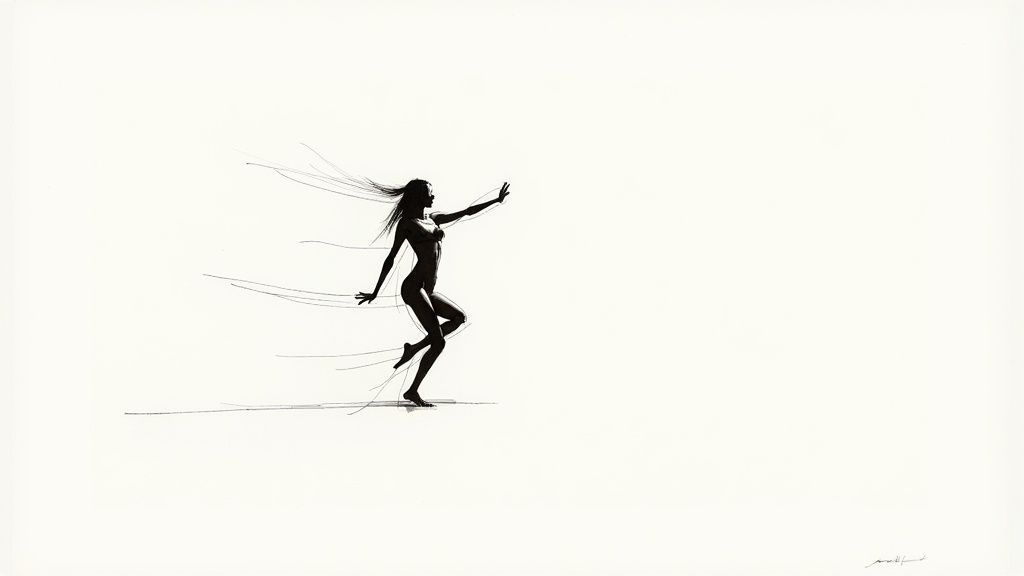
From the anatomical master studies of the Renaissance to the foundational training exercises at Disney, figure and gesture work teaches artists to see the body as a series of interconnected, dynamic forms. The practice was famously championed by educators like Kimon Nicolaides and Walt Stanchfield, who taught artists to feel the pose rather than just copy its outline.
How to Get Started
The goal of gesture drawing is to capture the essence of a pose quickly, building your intuitive understanding of the human form. This is not about creating a finished piece but about training your hand and eye to work together efficiently.
- Start with Short Poses: Begin with 30-second to two-minute sketches. This forces you to focus on the overall movement and avoid getting bogged down in details.
- Find the Line of Action: Identify the main curve or line of energy running through the pose, often from the head down through the spine to the feet. Build your sketch around this line.
- Use Your Whole Arm: Draw with broad, confident strokes originating from your shoulder, not just your wrist. This creates more fluid and energetic lines.
- Focus on Rhythm, Not Details: Ignore facial features, fingers, or clothing folds in quick gestures. Instead, concentrate on the rhythm, weight distribution, and overall shape of the figure. For more tips on this, explore dynamic figure drawing techniques.
5. Urban Sketching
Urban sketching is the art of drawing on location in cities, towns, and other urban areas. This practice emphasizes capturing the life and atmosphere of a place through direct observation, turning your sketchbook into a visual diary of your surroundings. It's a wonderful sketch drawing idea for artists who want to connect with their environment, documenting everything from grand architecture and bustling street scenes to quiet corners and candid moments.
Popularized by artists like Gabriel Campanario, founder of the Urban Sketchers organization, this movement celebrates the diversity of styles and subjects found in everyday life. The focus is less on creating a perfect, polished piece and more on the act of seeing and recording a moment in time, making it an accessible and deeply personal practice.
How to Get Started
Getting started with urban sketching is all about embracing the spontaneity of your environment. Pack a small kit and find a spot that catches your eye.
- Keep Your Kit Simple: Begin with a sketchbook, a pen, and perhaps a small watercolor set. A limited palette encourages you to work quickly and focus on value and form.
- Capture Atmosphere Over Accuracy: Don’t worry about perfect perspective or replicating every detail. The goal is to convey the feeling of the place. Focus on light, shadow, and movement.
- Set a Time Limit: Challenge yourself with quick 15 or 30-minute sketches. This forces you to simplify complex scenes and capture the essential elements without overthinking.
- Join a Community: Look for a local Urban Sketchers group. Drawing with others provides support, motivation, and a great way to discover new locations and techniques.
6. Animal Studies
Animal studies involve capturing the diverse forms, textures, and movements of the animal kingdom. This practice challenges artists to understand unique anatomies, from the powerful muscles of a big cat to the delicate structure of a bird's wing. It’s an essential skill for anyone interested in wildlife art, character design, or simply bringing more life to their work, making it a dynamic sketch drawing idea.
From the scientific precision of John James Audubon to the expressive energy in Disney’s early character development, animal drawing has a rich history. The key is to look past the fur or feathers to the underlying bone and muscle structure, which dictates how an animal moves and holds itself.
How to Get Started
Begin by observing animals in relaxed states before tackling the challenge of capturing them in motion. This approach allows you to build a solid understanding of their form and proportions.
- Start with Resting Animals: Sketching a sleeping pet or a stationary animal at a zoo is an excellent way to study its anatomy without the pressure of movement.
- Study Basic Skeletons: Familiarize yourself with the fundamental skeletal structures of common animal groups (e.g., felines, canines, equines). This knowledge will make your drawings more believable.
- Practice Quick Gesture Sketches: When animals are moving, use rapid, continuous lines to capture the essence of their action and flow. Don't worry about details; focus on the overall form and energy.
- Use Photo References: Supplement live observation with high-quality photos. They allow you to study details like fur texture, eye reflections, and specific markings up close.
7. Architectural Drawing
Architectural drawing is a captivating sketch drawing idea that centers on capturing buildings and man-made structures. It merges artistic expression with technical precision, challenging artists to master perspective, proportion, and the play of light and shadow on structural forms. This practice is about more than just drawing buildings; it’s about conveying the character, scale, and atmosphere of a place.
From the dramatic, moody renderings of Hugh Ferriss to the intricate etchings of Giovanni Battista Piranesi, architectural sketching has long been a way to document and interpret our built environment. The core challenge is translating complex three-dimensional structures onto a two-dimensional plane with accuracy and style.
How to Get Started
A successful architectural sketch relies on a strong structural foundation. Begin by focusing on the overall form and perspective before diving into the smaller, more decorative elements.
- Master Perspective: Start by learning one and two-point perspective. These principles are fundamental to creating the illusion of depth and distance in your drawings.
- Simplify to Shapes: Break down complex buildings into basic geometric shapes like cubes, cylinders, and pyramids. Block these in first to ensure correct proportions.
- Use Construction Lines: Don't be afraid to use a ruler for initial guidelines to establish straight lines and accurate angles. You can draw over them more loosely later.
- Observe Light and Shadow: Pay close attention to how light hits the building. Shadows define form, create contrast, and add a sense of realism and drama to the sketch. An architectural detail study can help you practice rendering different materials and textures.
8. Fantasy and Imagination Drawing
Fantasy and imagination drawing is the art of bringing concepts from your mind to life on paper, free from the constraints of reality. This practice allows you to sketch mythical creatures, otherworldly landscapes, and futuristic technology, blending foundational skills with creative visualization. It's a key discipline in concept art and illustration, where the goal is to invent and visually communicate new worlds.
Pioneered by artists like Frank Frazetta and Hayao Miyazaki, this form of drawing is responsible for the iconic visuals in video games, films, and literature. The challenge is not just to create something new but to make it believable within its own context, combining anatomical knowledge with creative design.
How to Get Started
A successful fantasy sketch is grounded in reality, even if its subject is entirely fictional. Build a strong visual library and apply real-world principles to make your creations feel tangible.
- Build Strong Foundational Skills: Master perspective, anatomy, and lighting before inventing new things. A dragon's wing will look more convincing if you understand how a bat's wing works.
- Use Photo References: Combine real-world references to create something new. For example, use photos of lizards, rocks, and trees to inform the texture and form of a creature's skin.
- Develop Internal Logic: Establish consistent rules for your world. How does the magic work? What is the technology level? This consistency makes your designs more cohesive and believable.
- Tell a Story: Use your composition to hint at a larger narrative. A lone warrior overlooking a vast, ruined city tells a different story than a bustling market in a fantasy metropolis. You can practice this by sketching a detailed fantasy castle and imagining its history.
9. Botanical Illustration
Botanical illustration is the detailed and scientifically accurate drawing of plants, flowers, and other botanical specimens. This discipline merges artistic skill with scientific observation, demanding precise attention to a plant's structure, texture, and identifying characteristics. It stands out as a unique sketch drawing idea by transforming a simple subject into a study of nature's complexity.
From the pioneering work of Maria Sibylla Merian to the detailed collections at the Royal Botanic Gardens, Kew, botanical art has a rich history of documenting the natural world. The goal is to create an image that is not only beautiful but also serves as an accurate record for identification and study.
How to Get Started
Success in botanical sketching comes from careful observation and a systematic approach. Rather than drawing the flower as a whole, focus on its individual components and how they fit together.
- Work from Fresh Specimens: Whenever possible, draw from a live plant. This allows you to observe its three-dimensional form, true colors, and subtle details that photos often flatten or distort.
- Study Plant Anatomy: Familiarize yourself with basic botanical terms like petal, stamen, and sepal. Understanding how a plant is constructed will dramatically improve the accuracy of your sketches.
- Use Magnifying Tools: A simple magnifying glass can reveal intricate details in veins, pollen, and textures that are invisible to the naked eye, adding a layer of realism to your work.
- Start with Simple Structures: Begin with a single leaf or a simple flower, like a daisy or a tulip. This helps you practice capturing form and detail before moving on to more complex subjects like orchids or composite flowers.
10. Character Design and Development
Character design and development is the art of creating unique, memorable figures for stories, games, and animation. This discipline is a fantastic sketch drawing idea because it blends artistic skill with narrative storytelling, challenging you to communicate personality, history, and emotion through visual cues alone. It’s about building a character from the inside out, ensuring their appearance reflects their role and inner world.
From the iconic silhouettes of Hayao Miyazaki’s creations to the expressive faces crafted by Glen Keane for Disney, strong character design is fundamental to compelling visual media. The practice involves much more than just drawing a figure; it requires thinking like a costume designer, an actor, and a storyteller all at once.
How to Get Started
To create a compelling character, begin with broad concepts and refine your way toward the final details. This approach ensures your design is both unique and functional for its intended purpose.
- Start with a Strong Silhouette: A character should be recognizable from their outline alone. Experiment with different shapes and proportions to create a memorable and dynamic silhouette before adding any internal details.
- Design from Personality Outward: Before drawing a single line, define your character’s core personality traits. Are they brave, timid, cunning, or clumsy? Let these traits guide your choices in posture, expression, and clothing.
- Create Multiple Variations: Don't settle on your first idea. Sketch multiple versions of the character, playing with different hairstyles, outfits, and facial features. This "thumbnailing" process helps you discover the strongest possible design.
- Consider Movement and Emotion: Think about how your character will move and express themselves. A flexible, agile character will have a different build and costume than a rigid, stoic one. Sketch them in various poses and with different expressions to test the design's versatility.
Top 10 Sketch Drawing Ideas Comparison
Drawing Type | Implementation Complexity | Resource Requirements | Expected Outcomes | Ideal Use Cases | Key Advantages |
|---|---|---|---|---|---|
Portrait Sketching | Intermediate to Advanced | Live models or good photo refs; understanding of facial anatomy | Accurate likeness and expressive character | Portrait art, character studies | Develops strong observational and anatomy skills |
Nature and Landscape Sketching | Moderate | Portable materials; outdoor access | Captures natural scenes with atmosphere | Outdoor art, nature study, quick sketches | Encourages outdoor activity and quick sketching |
Still Life Drawing | Beginner to Intermediate | Controlled indoor setup and lighting | Detailed studies of form, texture, and light | Skill building, studio practice | Full control over environment and subjects |
Figure Drawing and Gesture Studies | Intermediate to Advanced | Live models or pose references | Dynamic human figures, confident lines | Animation, illustration, anatomy practice | Builds quick observational skills and understanding of movement |
Urban Sketching | Moderate | Portable, compact gear; outdoor access | Captures urban life and architecture | Visual journaling, travel documentation | Builds confidence drawing in public, strong community support |
Animal Studies | Intermediate | Live animals or photo references | Anatomical and behavioral animal sketches | Illustration, wildlife art, animation | Develops diverse anatomy knowledge and movement capture |
Architectural Drawing | Advanced | Understanding of perspective; outdoor drawing | Precise building representations | Architecture, design visualization | Combines technical and artistic skills |
Fantasy and Imagination Drawing | Advanced | Strong foundational skills; references for anatomy | Creative, imaginative artworks | Entertainment industry, concept art | Complete creative freedom, valuable for media careers |
Botanical Illustration | Advanced | Scientific tools; fresh specimens | Highly detailed, accurate plant drawings | Scientific documentation, field guides | Combines art with scientific accuracy |
Character Design and Development | Advanced | Diverse skill set; multimedia references | Distinctive, narrative-driven characters | Animation, games, comics | High demand in entertainment; develops design thinking |
Turn Inspiration into Action
We’ve journeyed through a comprehensive collection of sketch drawing ideas, touching on everything from the subtle expressions of a portrait to the grand scale of an urban landscape. This curated list, spanning from figure drawing and animal studies to the imaginative realms of fantasy, is designed to be more than just a temporary fix for artist's block. It's a foundational resource to fuel your creative engine for months to come.
The true value of these prompts lies not in completing them all, but in using them as a catalyst for consistent, deliberate practice. The path from a novice artist to a seasoned creator is paved with countless sketches, each one a small lesson in form, light, and composition.
From Prompt to Progress
Think of this list as your personal art curriculum. To make the most of it, consider these actionable strategies:
- Combine and Conquer: Don't let these categories exist in isolation. Challenge yourself by merging prompts. Try sketching a fantasy character in a detailed architectural setting or creating a still life composed of objects found during an urban sketching trip. This cross-pollination of ideas is a powerful way to develop a unique artistic style.
- Identify Strengths and Weaknesses: As you work through these prompts, take note of what feels natural and what presents a significant challenge. Do you excel at capturing the gesture of a figure but struggle with the precise lines of a building? Leaning into those difficult areas is where the most substantial growth occurs.
- Build a Thematic Series: Instead of jumping randomly between ideas, select one category, like botanical illustration or character design, and create a series of 5-10 related sketches. This focused approach allows for a deeper exploration of a single subject, helping you master its nuances and build a cohesive body of work.
The Power of a Full Sketchbook
Ultimately, the goal is to transform these sketch drawing ideas from a passive list into an active, dynamic part of your artistic routine. A full sketchbook is not just a collection of drawings; it is a tangible record of your progress, a library of your experiments, and a testament to your dedication. It documents your evolving perspective, your technical improvements, and the development of your unique voice.
Each page you fill, whether with a quick gesture study or a detailed still life, reinforces your skills and builds creative momentum. Embrace the process, celebrate the small victories, and remember that every line you draw is a step forward on your artistic journey. The blank page is no longer an obstacle; it's an open invitation.
Ready for an endless stream of creative sparks? If you're looking for a continuous supply of unique sketch drawing ideas tailored to your interests, check out the prompt generator from Drawing List. It's the perfect tool to keep your creativity flowing and ensure you never face a blank page again. Explore thousands of new prompts at Drawing List.
